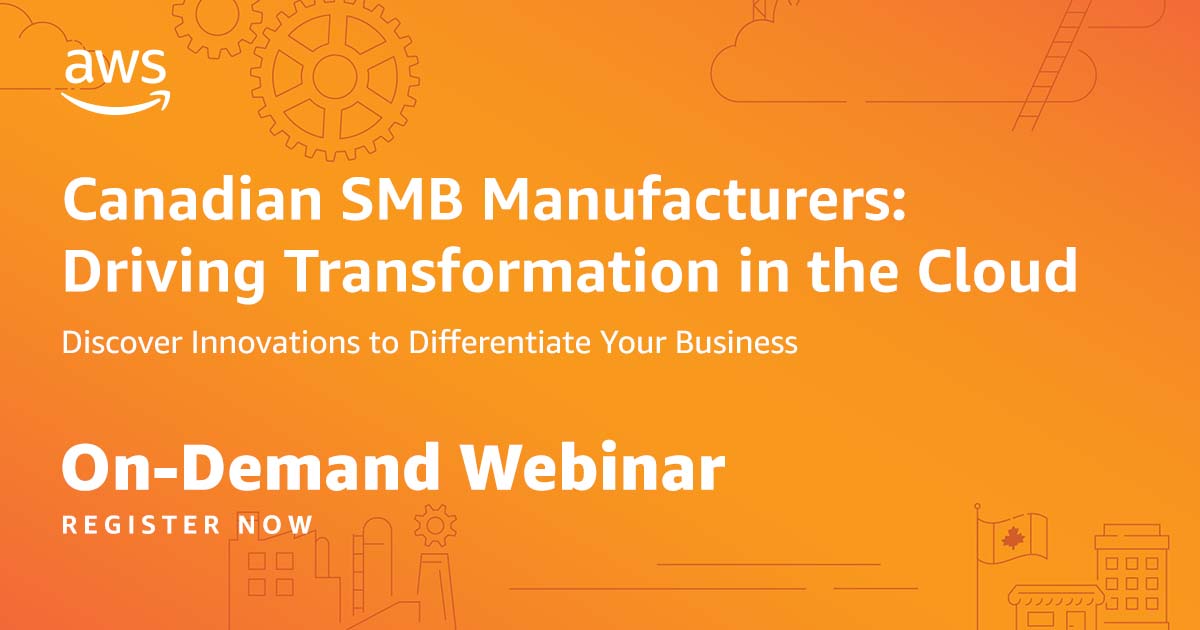
Cloud computing raises the ceiling for manufacturers of all sizes
by AWS

Sponsored by AWS
Manufacturers and industrial suppliers of all sizes should be thinking about their own business transformation and how they can benefit from connected devices and IoT.
The manufacturing sector has been undergoing a steady transformation from businesses based on machine-to-machine technology to those increasingly leveraging the Internet of Things (IoT) to drive innovation and achieve new outcomes. There are now dozens of examples of large, global players in the space that have successfully adopted IoT and reaped the benefits of more connected infrastructure.
Every day, companies are generating huge troves of data at the edge, storing this information in the cloud, and using those assets to rethink virtually all of their processes. But the power of cloud computing means this type of transformation isn’t just available to the sector’s largest companies. Businesses of all sizes can get on board.
SMB manufacturers, in particular, face a host of challenges on the path to business transformation: supply chain crunches, quality control issues, plant floor inefficiencies, asset management. To differentiate their business, SMB manufacturers need to enable innovation, fully leverage their data, and increase agility—all while controlling operating costs. It’s a balance that’s now achievable through cloud computing.
From operational efficiency to customer success and beyond, here are four key ways connected devices and the Internet of Things are modernizing industrial processes for companies large, medium, and small:
Improving operational efficiency
Many industrial and manufacturing companies are looking to apply computer vision to assist in their efforts to optimize efficiency and improve operations. Today, companies manually review video feeds across their industrial sites to authenticate access to facilities, inspect shipments, and detect spills or other hazardous conditions. But doing this in real time is not only a difficult task, but error-prone and expensive. And while companies might seek to upgrade existing internet protocol (IP) cameras for smart cameras that have enough processing power to run computer vision models, that can be expensive. What’s more, even with smart cameras, achieving low latency performance with good accuracy can be challenging. Instead, industrial companies can use hardware appliances that allow them to add computer vision to existing on-premises cameras, or even use Software Development Kits to build new cameras that can run meaningful computer vision models.
Global energy company BP is looking to deploy computer vision at its 18,000 service stations worldwide. It’s working to leverage computer vision to automate the entry and exit of fuel trucks to BP facilities, and to verify that the correct order has been fulfilled. And computer vision can help alert workers if there is a collision risk, identify a foreign object in a dynamic exclusion zone, and detect any oil leaks.
Predictive maintenance of equipment
A common but significant challenge many industrial and manufacturing companies face today is the ongoing maintenance of their equipment. Historically, most equipment maintenance has been either reactive (after a machine breaks) or preventive (performed at regular intervals to help avoid machines breaking). Both are costly and inefficient practices. The best solution — predictive maintenance — gives companies the ability to foresee when equipment will need upkeep. However, most companies lack the necessary staff and expertise to build their own solutions.
Thankfully, for companies like GE Power – a leading provider of power generation equipment, solutions and services – predictive maintenance is finally within grasp. There are now end-to-end systems that use sensors and machine learning to detect and alert companies of abnormal fluctuations in machinery vibration or temperature, with no machine learning or cloud experience required. This type of technology helped GE Power quickly retrofit assets with sensors and connect them to real-time analytics in the cloud, moving from time-based to predictive and prescriptive maintenance practices. And as they scale, GE Power can use these systems to remotely update and maintain their fleet of sensors, without ever having to physically touch them.
Elevating customer support
As with any business transformation, customers are key catalysts for change, so they should feel a direct benefit in some way. Plant equipment running on desktop applications can lead to lengthy troubleshooting processes if things aren’t operating as they should. Cloud-based systems allow industrial suppliers to see what their customer is seeing, speeding up the troubleshooting process and reducing downtime on the floor.
For Toronto-based Mosaic Manufacturing, this enhanced flow of information between its support team and its customers strengthens those relationships. Its fully automated 3D printing system can run with no operator intervention for days at a time, but can be monitored remotely 24/7. Running on the cloud means Mosaic’s customers have a constant touchpoint with the company, enabling a richer and more consistent customer experience.
Securing revenue with added value
For SMB industrial and manufacturing companies, in particular, cloud-based offerings open up opportunities to build premium pricing models, or fee-for-access to certain features like advanced queuing or enhanced monitoring. This creates a new recurring revenue stream for the business based on a fee model that’s already familiar to customers in the space.
Cloud-based offerings can also reduce backend costs, creating space to add more features and value for customers. Mobiltex, a Calgary-based company specializing in pipeline monitoring for the natural resources sector, has been able to invest reductions in its data backhaul costs — generated by cloud efficiencies — into improving its service offering, elevating its customers’ experience without increasing their fees.
The next industrial revolution is taking place in the cloud. Manufacturers and industrial suppliers of all sizes should be thinking about their own business transformation and how they can benefit from connected devices and IoT, and even more advanced technologies like machine learning.
Visit the AWS site to experience an on-demand webinar diving into how the cloud has helped transform manufacturing businesses to keep them competitive in a new environment.
